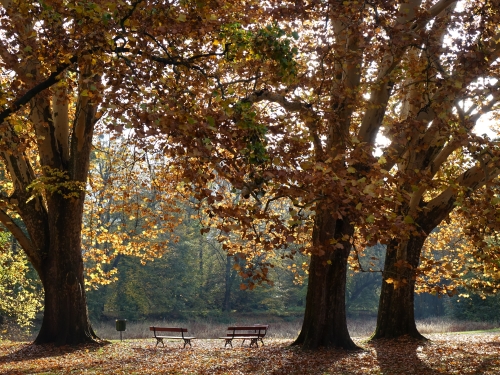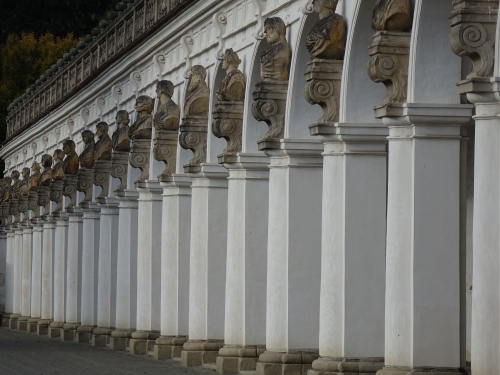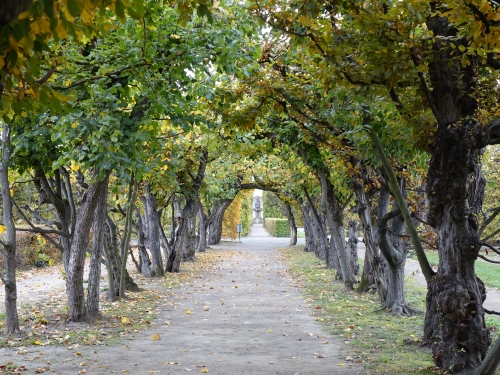Blog WHS Visits
WHS #684: Kromeriz
During my ‘Czech 3 castle WHS weekend’ I stayed overnight in Kromeriz. It lies about half-way between Litomysl and Lednice/Valtice, and probably is the nicest of these towns. The hotel La Fresca and its restaurant are warmly recommended anyway. Its menu was only written in the Czech language, probably a sign that not too many foreign tourists stay for the evening and night. My reason for being here of course was the Gardens and Castle in Kroměříž, which have played an important role in the development of the baroque palace and garden design in Central Europe.

The WHS consists of 2 locations: the Castle and its garden (1) and the Pleasure Garden (a.k.a. Flower Garden) (2). Both are walkable from the city square. The locations are well-signposted and even connected to each other via a route with partial WH logo’s incorporated in the pavement at frequent intervals. I knew beforehand that the castle probably wouldn’t be worth entering (although it houses “a splendid art collection”), so I just focused on both gardens during my 1.5 hour visit on an early Sunday morning.
The garden at the castle opens its gates already at 7 o'clock. So after breakfast I first went to have a look at that one. It is a landscape park in English style - so 'just' a park that you see in so many places in Europe. It has hiking paths, benches, ponds, a bridge. There are also peacocks and a kind of petting zoo. I encountered a black rabbit on one of the paths that had probably escaped from it. Entrance is free here. It is nice enough for a stroll, especially with the autumn colours setting in.

The Pleasure Garden lies some 15 minutes away, on the other side of the square in a residential neighbourhood. It opens at 9 am and a 80 CZK (3.10 EUR) entrance fee is charged. This is actually the only element of this world heritage that has something special. It apparently is a rare well-preserved garden from the 17th century, designed in the Italian garden style and still intact in its original baroque design. The eye-catcher is the 244-meter-long archway, with a statue in each niche and a bust on each arch.
The garden itself consists of many straight paths that all end up at the central Rotunda. Furthermore, there are many creatively cut hedges. It must be a hell of a job to keep this maintained, but it looks neat. There’s also a ‘Dutch garden’ – I had never heard of the specific type (gardening is not really a subject of interest to me), but it is a small rectangular garden space with flowers planted in it!

This is the 8th review of the Gardens and Castle of Kromeriz on this website in over 12 years and I can not think of any new angle of approach in describing its values or visiting experience. Everything that can be told about it has already been written down. The nomination file goes into great detail about the castle’s art collection, library, numismatic collection – most of it moveable objects which shouldn’t be rewarded in a WHS. This should be about the garden(s), but I’d rather recommend the originals in Italy.
Els - 24 October 2018
Comments
Solivagant 25 October 2018
“There’s also a ‘Dutch garden’ – I had never heard of the specific type (gardening is not really a subject of interest to me), but it is a small rectangular garden space with flowers planted in it!”
As is often the case when one delves into a subject, it soon raises issues and inconsistencies!!
A “Dutch Garden”? Well surely it is all about bulbs, tulips etc!!! Indeed, this 2014 article about Kromeritz from the Japan Times states “Dutch Garden. Growing bulbs - called “Dutch” flowers - was a prestigious activity among the upper class in the 16th and 17th centuries. These spring-blooming flower beds have been restored with 20,000 bulbs of tulips, daffodils, hyacinths and Kaiser’s crown (or crown imperials). The Dutch Garden also includes a fountain with the original statue of a water god, and is considered one of the Flower Garden’s most authentic spots.”
Although all this might please tourists visiting Kromeriz in Spring and expecting to see tulips in a “Dutch Garden”, it is, as far as I can discover, not what the garden would have really been about. The pleasure gardens were constructed mainly 1665-75 and the height of “Tulip mania” in the Netherlands had occurred before then (c1637) but the references I can discover about the phrase “Dutch Garden” hardly mention the tulip!! My photos of the information boards in the Kromeriz museum describe the “Dutch garden” without mentioning those plants – it was all about walls, water and a statue!
The magazine “Garden History” produced an article titled “Who knows what a Dutch Garden is?” (https://www.jstor.org/stable/1587248?read-now=1&googleloggedin=true&seq=2#page_scan_tab_contents ). It concentrates far more on the design and lay out than on flowers. “High hedges and walls, ponds or canals. Tight arrangement of spaces and the use of vistas, both consistent with the long and thin shapes of land parcels in NL”
Wiki says “The Dutch garden is distinguished by its dense atmosphere and efficient use of space” and “In England, Dutch garden was the description given to a particular type of rectangular garden space, often enclosed within hedges or walls ……. This space would be laid out in a highly cultivated and geometrical, often symmetrical, fashion, shaped by dense plantings of highly coloured flowers, and edged with box or other dense and clipped shrubs, or low walls (sometimes in geometrical patterns), and sometimes, also, with areas of artificial water, with fountains and water butts, which were also laid out in symmetrical arrangements. The flower beds and areas of water would be intersected by geometrical path patterns, to make it possible to walk around the garden without damaging any of its features”.